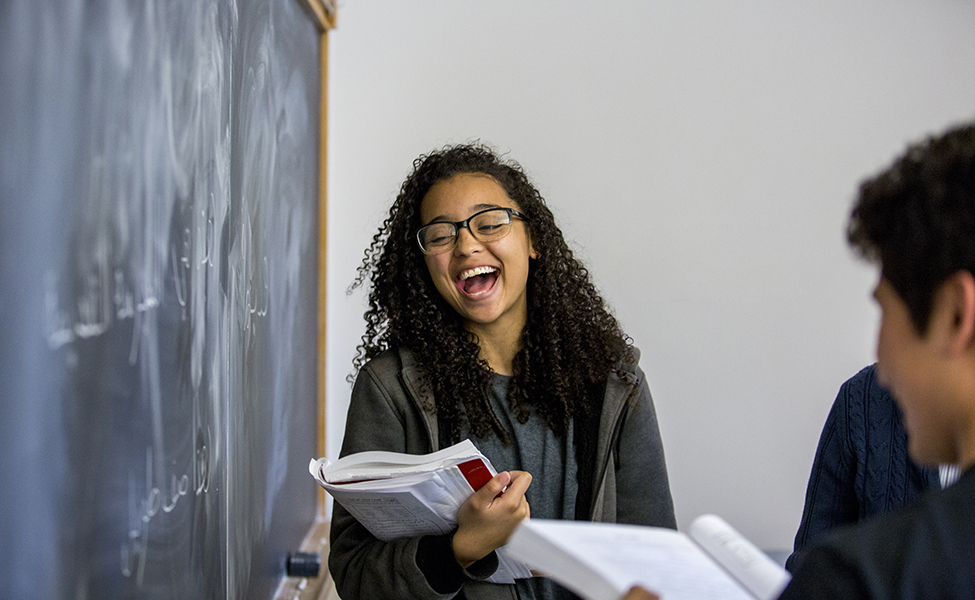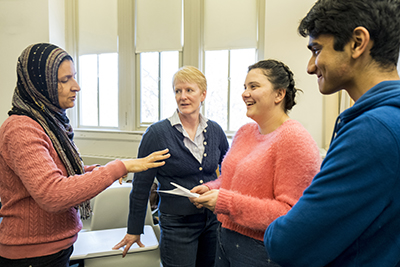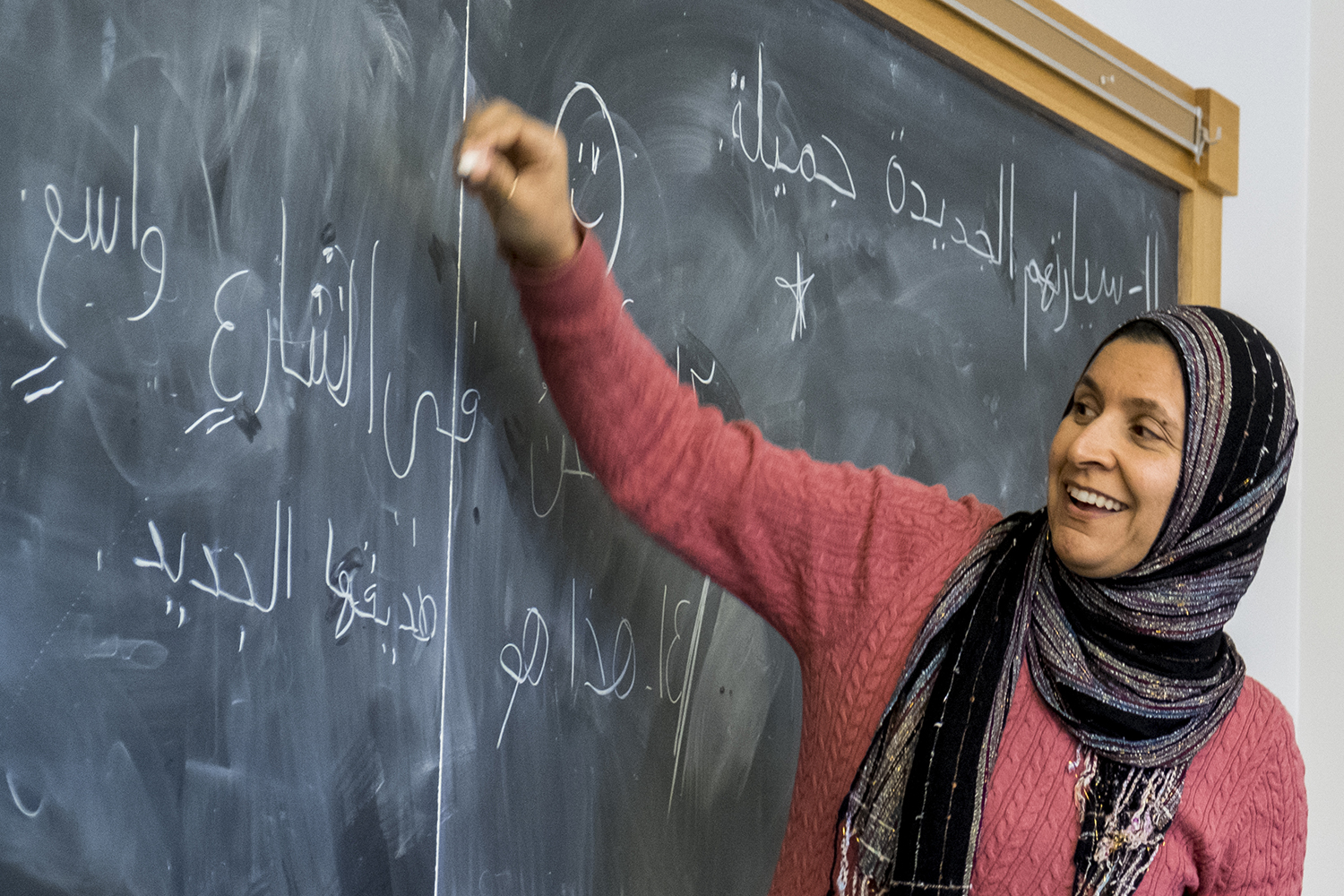Studying Arabic for Fun
When I told my coworkers last fall that I was taking Beginning Arabic I, their eyes grew round and they said things like, “You’re brave,” or “Whew! Good luck.” I thought they were joking.
Okay, sure, Arabic uses a different alphabet and it reads from right to left. And my 49-year-old brain is not as willing to memorize vocabulary as it once was, or perhaps it’s just more cluttered than it was at 19. But I was not the least bit nervous about taking Arabic. In fact, I was ridiculously excited. Learning new things is so much fun and I particularly like language. It’s such a window into different ways of thinking; and as a writer, I am always fascinated by how others think. Because I was a French major at Grinnell, I also felt confident in my ability to learn Arabic. Perhaps too confident.
On the first day of class, 15 or 16 students crowded inside ARH 322, a small classroom with three tall windows overlooking Park Street and two walls filled with chalkboards. We sat in two messy, nesting semicircles, facing the widest chalkboard. At 1 p.m., Mervat Youssef, associate professor of Arabic, strode into the room speaking Arabic. Alarm flickered across people’s faces.
Mervat pointed at herself and said, “Issmee Mervat.*” She swept an arm around the room, as though gathering us all in like a flock of chicks. “Issmee,” she said again, beckoning us with her hand to speak. “Issmee,” we repeated and inserted our own names. It sounded a lot like “It’s me, Michele.” One word plus our own names? We could do this.
“I really liked [Arabic] from day one when we were being made to feel uncomfortable,” said Moises Herrera ’19. “She just started talking and we didn’t know what she was saying and eventually we got the hang of it.”
The first day “felt like someone had picked me up and dropped me in Egypt,” said Cora Touchstone ’19, a transfer student from Georgia who took Arabic “on a whim.” It gave her a bit of a panicky feeling.
 Other students may have felt some panic too. On the second day of this five-day-a-week class, there were more empty seats in the room. By day three, the class was about two-thirds the size it was on day one. A Grinnell High School freshman stuck it out for two weeks; I suspect the heavy load of homework got to him as it was already getting to me. Two hours a night — are you kidding me?
Other students may have felt some panic too. On the second day of this five-day-a-week class, there were more empty seats in the room. By day three, the class was about two-thirds the size it was on day one. A Grinnell High School freshman stuck it out for two weeks; I suspect the heavy load of homework got to him as it was already getting to me. Two hours a night — are you kidding me?
Introducing our Arabic teacher
Teaching her native language was not in Mervat Youssef’s career plan. She was a radio journalist in Egypt before coming to the Midwest to study journalism and mass communication. She was finishing her dissertation at the University of Iowa in 2007 when she first heard about Grinnell. She was invited to read some poetry of Muḥyiddin Ibn ’Arabi, a Sufi mystic, as part of a celebration of the three Abrahamic traditions. “I was smitten [with Grinnell],” she said.
Grinnell was apparently smitten too, because the event organizers told her the College was planning to start an Arabic program and invited her to apply. Arabic had been offered as a language through the Alternative Language Study Option since 2003 and was growing in popularity.
Yet Mervat wasn’t convinced teaching Arabic was in her future. “That’s not what I had in mind when I ended up in grad school,” she said. “I wanted to teach journalism.” Her dissertation adviser pointed out that she was already doing Middle East studies (her dissertation was about how Arab Americans were negotiating their Americanness on opinion pages), that she was bilingual, and that Grinnell is a great place.
She also knew a Grinnellian, Sarah Burke Odland ’97, who was in the same doctoral program. “She was fabulous, very smart, and I always admired her,” Mervat said. “I thought, oh my gosh, if the students are like Sarah Burke, life would be good.”
In fall 2008, Mervat began teaching Arabic on a two-year contract. “I thought this was a great opportunity,” she said. When the position was advertised as tenure-track, she applied. She earned tenure in 2016. “I came and I stayed.”
The former journalist didn’t study how to teach a foreign language. “I think my teaching is reflective of how I learned,” she said. She learned English through immersion while attending a Catholic elementary school in Kuwait, where she was born and grew up. She learned German in high school the same way. “I’ve been inspired by all the great teachers that I had,” she said. One of those teachers was her father.
“I remember vividly how he taught us to swim,” she said. “He got some empty bottles of Pepsi. They’re plastic so they floated. He told us that if he wraps them around us, just two of them, they would make us float. So when we swam, we thought that we were being held with the bottles. Then he took one off and took the other one off, and we were swimming. I don’t think he lied to us because he showed us that it floats. But in our brains we can’t understand the physics behind it, so we got the confidence to just jump. And that became my main thing in teaching. Start speaking.”
Learning from scratch
We spent the first two weeks learning to read, write, and pronounce the alphabet. I was reminded of how random our English letter signs are for the different sounds we use. Arabic is wonderfully phonetic. For example, there is a single letter for the “sh” sound that in English we find in “dish” and “nation.”
To my American ears, some Arabic letters sound quite similar to each other, like a “tuh” sound that’s made next to your teeth versus a back-of-the-tongue “tah” sound. Consequently, my spelling ability, once a forte in English, is less so in Arabic. The letter that probably bedevils me more than any is one we don’t have in English. “Ein” has a guttural, back-of-the-throat sound.
Besides learning how to pronounce all these letters, we also learned to write them. Arabic is written exclusively in a script form, but not all letters connect to each other. So each letter has four different ways of appearing in text, depending on whether it’s at the beginning of a word and connects to a letter after it, or if it’s in the middle, the end, or by itself. “Ein,” for example, looks very different depending on its place in a word.
To further complicate my spelling efforts, some letters have precisely the same shape as other letters. The only difference is where the “cookie,” a dot about the size of a period, is located. A “B” sound has a single cookie below it while the “N” sound has a single cookie above. I still occasionally misplace my cookies and create words that make no sense.
Learning to read in Arabic felt a bit like being in first grade. Mervat wanted us to sound out the words, one letter at a time. “Cover and release,” she said, over and over. Covering the later letters in the word helped us focus on the pronunciation of each individual letter.
We quickly graduated to learning vocabulary. Grammar came along for the ride. Even on the first day, though I didn’t realize it at the time, Mervat was subtly introducing us to grammar. After we practiced saying, “Issmee” plus our names, she introduced the question that would elicit that answer. “Mah issmookah?” she said to male students and “Mah issmookee?” to female students. It wasn’t until many weeks later that we formally learned about the suffixes used to indicate the gender of the person being addressed.
The immersion approach to learning a language was new for me. I learned French a few years before that shift in language pedagogy occurred. Mervat is very good at acting things out and explaining things in Arabic with simple words in ways that we all could understand. To convey the plural version of a noun, for example, she’d tick off on her fingers its singular form, “weh-LEYE-uh, weh-LEYE-uh, weh-LEYE-uh, weh-LEYE-uh, weh-LEYE-uh,” (it means “state”) and then give us the plural form, “wi-LEYE-uh-tuh” (“states”).
Class itself was intense and fast-paced. “You constantly have to be focused and I really like that in Mervat,” Moises said. “She really knows when someone’s lost their train of thought.”
“You can’t get by without being fully engaged,” said Sarah Cannon ’19. “It’s the only class where I was actively learning the whole time.” She also found the class “exciting because it was 100 percent new.”
I thought when I enrolled that I’d be able to practice with my husband. He studied Arabic intensively for nine months in 1971, when he worked for CIA, but he has forgotten a lot and doesn’t know how to read it at all. When I practiced reading aloud to him, he often couldn’t understand me because he learned the Lebanese dialect, which has different vocabulary and was not the dialect spoken in Morocco where he was stationed. When he’d hear a word he didn’t recognize, he’d say, “That must be Egyptian Arabic.” I’d say, “No! It’s modern standard Arabic.”
What I didn’t anticipate was all the studying required. Mervat wasn’t kidding when she said two hours of studying per hour of class. I confess that I didn’t study that much every night, especially after fall break. Sometimes I did the minimum to complete the homework rather than follow the suggested study method: Listen to the vocabulary words, write each one three times while saying it out loud, then use it in a sentence. I discovered that it’s an effective study method, but not quick.
Nor did I attend the Arabic language lab, which was held from 7 to 8 p.m. Monday through Thursday. I’m sure it would have been helpful because Tarik Taghzouti, the Arabic language assistant and Fulbright scholar, was very helpful both in class and during his office hours. Back home in Morocco, he’s a secondary-school English teacher. His expertise in breaking down concepts into simple bits was evident when he explained to me, in Arabic, how possessives work.
A humbling experience
 Even though I was auditing the class, not taking it for credit, I did virtually all of the homework and took all of the quizzes and tests. I wanted to see how much I was learning and try to keep up.
Even though I was auditing the class, not taking it for credit, I did virtually all of the homework and took all of the quizzes and tests. I wanted to see how much I was learning and try to keep up.
But oh my, what a humbling experience to be the slowest student in the class. My French was more of a hindrance than a benefit. It was like an old dog who’s annoyed by the introduction of a new puppy and keeps trying to insert itself when I was searching for the Arabic words. On one quiz, a fill-in-the-blank question was looking for “with whom,” and all that would come to me was “avec qui,” the French, instead of “mah men.”
Right before fall break, Mervat mentioned the final presentations that we would do the last week of classes. We had to work with a partner and present — all in Arabic — for 10 to 15 minutes.
I wavered. Surely I had enough material to write a story about the class. I didn’t need to do a presentation, did I? Especially since I wasn’t being graded. Plus, I didn’t want to drag anyone else down with me.
And did I even have the stamina to stick with the class through the end of the semester? After all, I work full time. I have a husband, a dog who likes to go running, and no dishwasher. I’d rather work on my young-adult novel than use “ahhm” (paternal uncle) in a sentence. Studying each night was already more than I’d bargained for. Planning, writing, and practicing a presentation with a partner?
I finally decided to suck it up and do it. One day in class I asked Moises if he wanted to work together. To my surprise, he agreed. We had been frequent partners for in-class activities so I already knew him to be diligent and motivated and unafraid to speak Arabic. I told him I wouldn’t let him down.
Given our fairly limited vocabulary, I wasn’t sure what we could talk about for 10 whole minutes. So I suggested we pretend that it’s 2026 and we run into each other at a coffee shop in Grinnell and catch each other up on ourselves, our classmates, and teachers. He agreed. And that gave us license to make up virtually everything we presented. We didn’t know too many words for professions, so most classmates became teachers, one became an army officer, two became translators — Moises assigned himself to the United Nations. I remained a writer. We also gossiped about our classmates’ love lives. We made our audience laugh. That was reward enough.
Overall, taking Arabic was incredibly fun and mentally stimulating. It was probably more challenging to my ego than I would have liked, but it was a thrill to experience something new again.
“Are your brains exercised yet?” Mervat asked every day at the end of class. Yes, yes they are.
*Mervat Youssef is vehemently opposed to the use of transliteration in the learning of Arabic. We never used it in class. I’m using my own version of it here to give readers a sense of the language’s sound.
How Arabic became part of the curriculum
Arabic got its start at Grinnell thanks to student demand. In 2003, several students came to Dan Gross, then coordinator of the Alternative Language Study Option (ALSO) program, and asked for it.
ALSO is Grinnell’s self-instructional language program — students learn reading, writing, speaking, and understanding skills using textual and online audiovisual materials. ALSO students are tested by an outside evaluator, an instructor from another institution. One requirement for a language to be offered through ALSO is that a fluent speaker, often a fellow Grinnell student, be available as a conversation partner for the students to practice with three hours per week.
When Arabic was initially requested, a student from Alexandria, Egypt, was on campus and provided that support.
Arabic was offered through ALSO until 2006. Then the College tried a distance-based program for two years. “It was awkward and slightly clumsy,” Gross says, “and too slow for Grinnell students.” So the College decided to make Arabic part of the regular curriculum.

